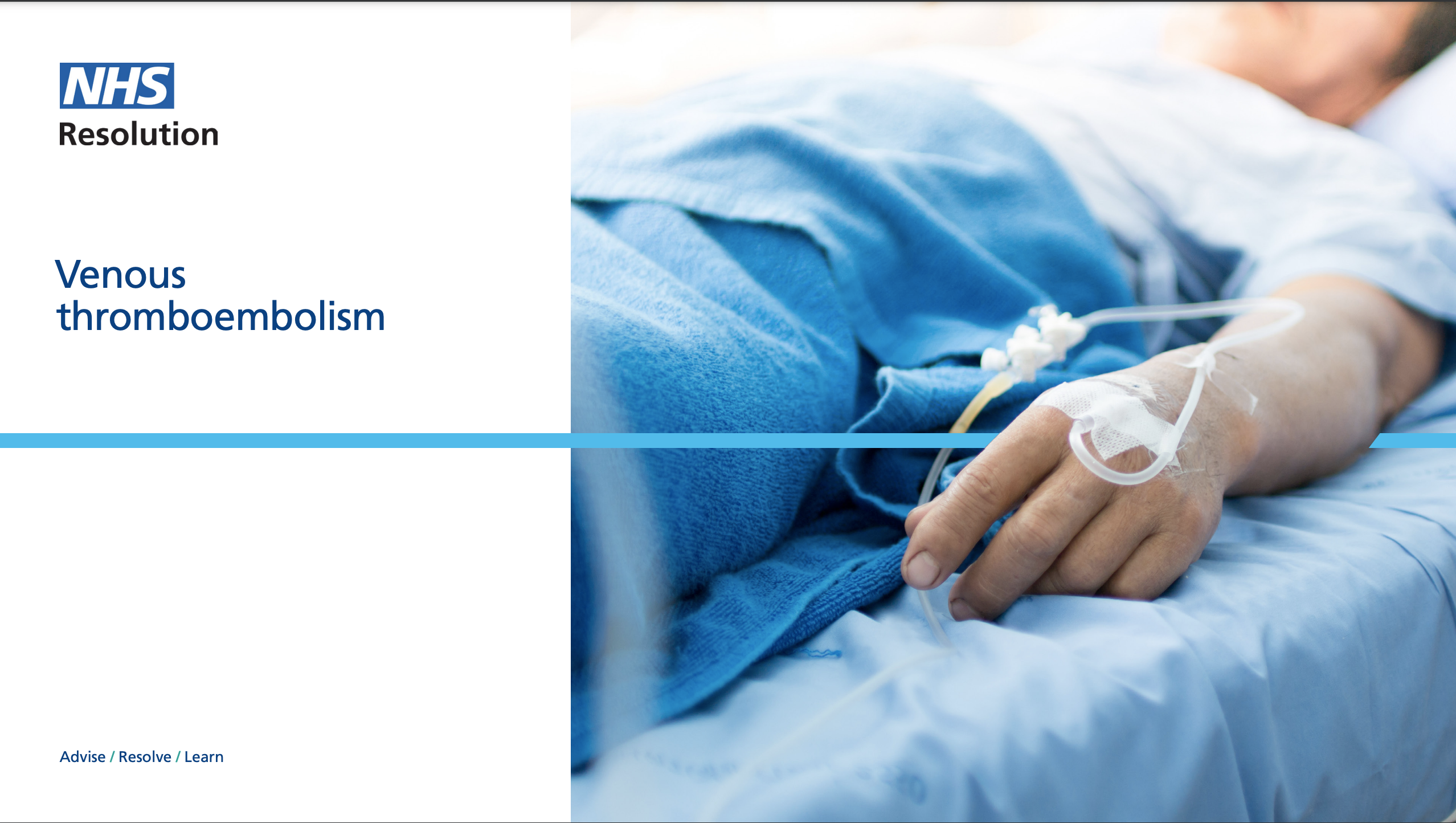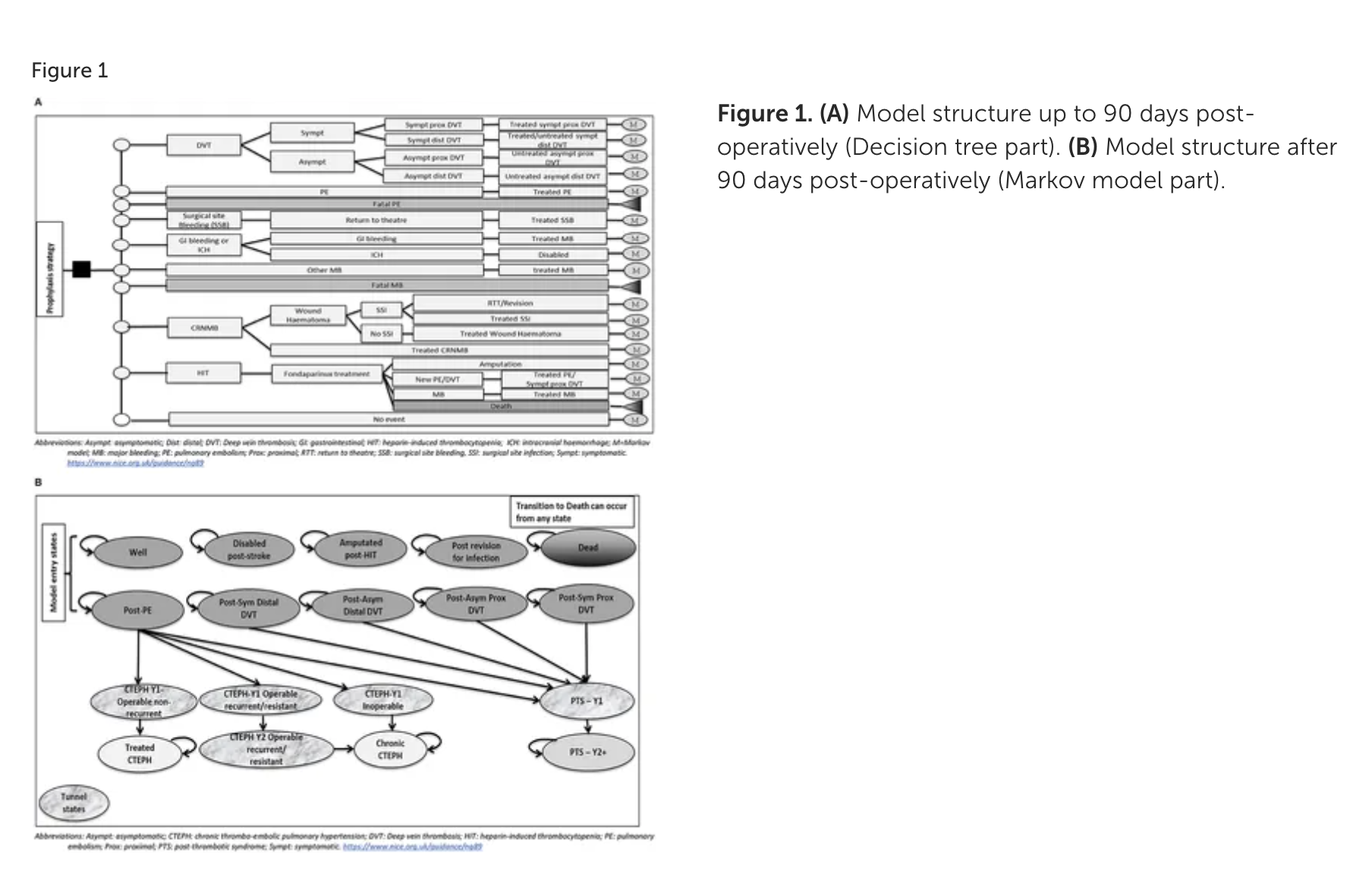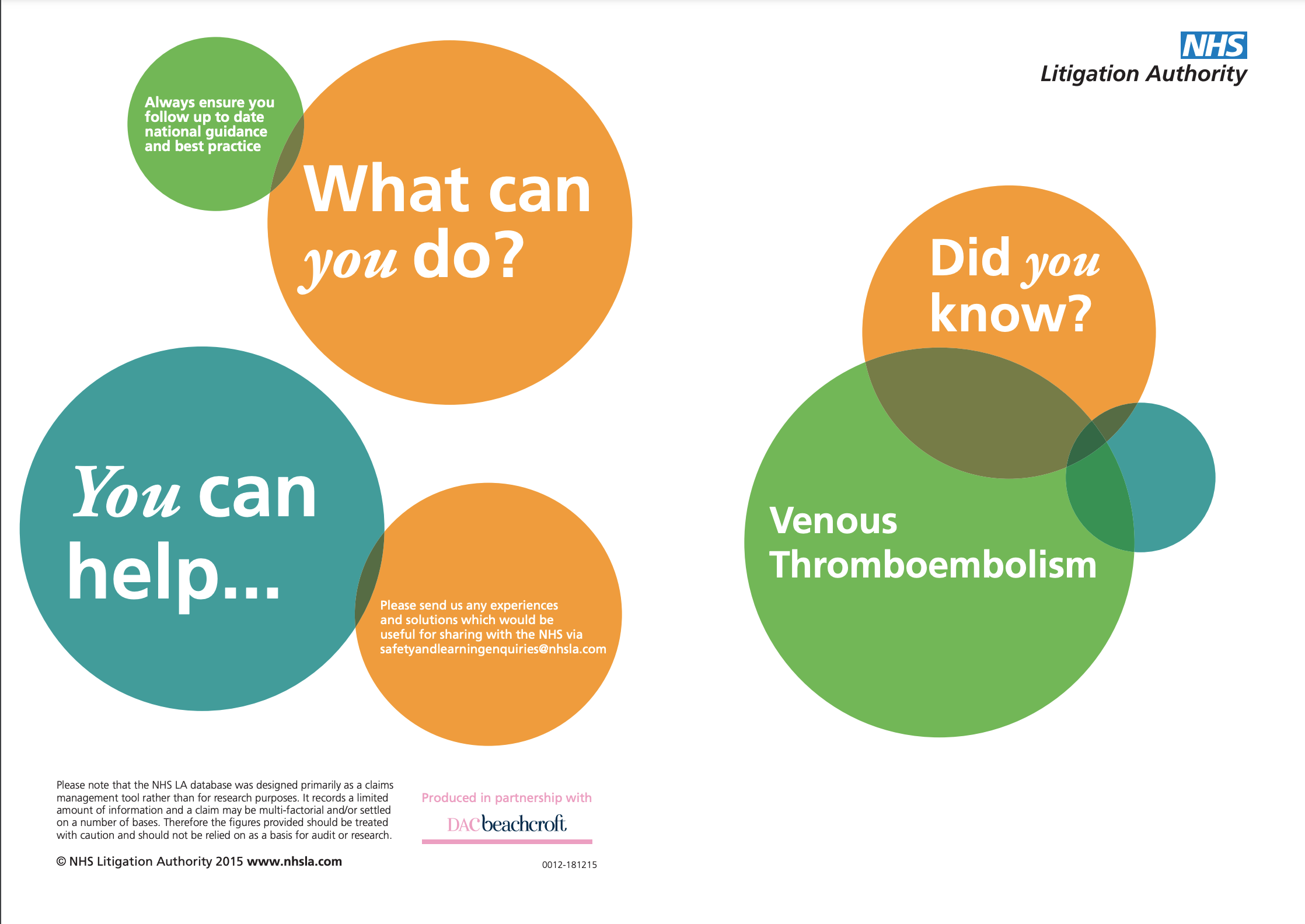VTE can affect anyone regardless of age, gender or ethnicity.
In the UK and worldwide, VTE is a leading cause of death and disability.
Up to 20% of cancer patients develop blood clots. Globally up to 60% of blood clots occur within 90 days of hospital discharge.
‘Classic presentation with abrupt onset of pleuritic chest pain, shortness of breath, and hypoxia is rarely the case. Studies of patients who die unexpectedly of pulmonary embolism reveal that they complained of nagging symptoms often for weeks before death related to pulmonary embolism.
Forty percent of these patients had been seen by a physician in the weeks prior to their death’.
Ref: Kline JA, Runyon MS. Pulmonary embolism and deep venous thrombosis. In: Marx JA, Hockenberger RS, Walls RM, editors. Rosen’s Emergency
Medicine Concepts and Clinical Practice. 6th ed. London: mosby; 2006. pp. 1368–1382
2 Safi M, Rostami RT, Taherkhani M. Unusual presentation of a massive pulmonary embolism. J Tehran Heart Cent. 2011 Winter;6(1):41-4. Epub 2011 Feb 28. PMID: 23074604; PMCID: PMC3466862

1 in 4 people die from causes related to blood clots.
One in twenty people will have a VTE at some time in their life and the risk increases with age.
55%-60% of VTE cases occur during or up to 90 days after discharge from hospital.
Every 37 seconds someone in the western world dies from a venous thromboembolism.
Every 6 seconds a person dies from VTE globally
Pulmonary embolism is the leading cause of maternal death in the developed nations.
Up to 20% of cancer patients develop blood clots.
Ref: Incidence of venous thromboembolism and its effect on survival among patients with common cancers
H Chew and others
JAMA Network, 2006. Vol 166, Issue 4. Pages 458-464
For individuals and health providers blood clots are costly. For individuals, impacting on income, employment and opportunities.
For health services, VTE is a major burden, cost and incurs significant NHS litigation costs.
For an individual, blood clots are not only a significant cause of death but have a life-long impact on lifestyle, often work, family planning and well-being as well as future health considerations. They can also cause disability and long-lasting ill-health problems.
For health care providers thrombosis remains a major cause of death in the UK, yet many people have little or no understanding about the causes and effects of thrombosis, and how it can be prevented.

The 2018 NICE VTE Guidelines on HAT (NG89) recommended that acute psychiatric in-patients should have VTE risk assessment and appropriate thromboprophylaxis.1 Despite this, the existing Department of Health VTE risk assessment tool does not include specific mention of factors relevant to psychiatric inpatients.
NHS England
Full VTE-related costs to the NHS are difficult to extract and can go undocumented, but in the APPG for Thrombosis, annual report 2016/17, a survey of English CCGs asked what their recorded costs for VTE treatment, hospital bed days, sanctions and litigation, for 2016/17.
Of the 22% of CCGs providing figures, the average annual cost for 2016/17 was £938,357 per CCG
(range spread from £63,358 South Lincolnshire to £7million in the Cambridge and Peterborough CCG area)
NHS Scotland
In Scotland, a 2018 freedom of information (FOI) in 2018 evidenced that between 2008 – 2017: 75,846 people were admitted to hospital for VTE in Scotland between 2008-2017
Over the same period, admissions with a diagnosis of VTE rose from 6,624 to 8,371
13,961 people died from a VTE episode in Scotland between 2008-2017
The number of patients dying of VTE in Scotland had increased by 1/3 between 2008-2017
70% of NHS Health Boards recorded more VTE-related deaths in 2017 than 2008
70% NHS Health Boards recorded increased VTE incidence in (2017 – 2008)
The cost of DVT and PE to NHS Scotland:








Applications are accepted on the basis that Thrombosis UK can share the content with external judges who will assist us with assessments. Service models, resources and working processes of successful Thrombosis UK VTE Award winners will be uploaded to the Thrombosis UK website and shared via publications, social media, and other opportunities.
When completing your application form, you should use lay language and answer each question in a concise manner.
Please keep to any word limits given.
All sections need to be completed, if any section is removed, omitted or incomplete, we cannot process the application.
Applications need to be submitted via email to: [email protected] You will receive a notification of receipt within 48 hours of submission. If you do not receive a notification, please email [email protected]
The closing date for applications is 1st February 2025
We are unable to consider late applications.
Thrombosis UK has a strict data protection policy that complies with UK data protection law.
Your name and contact details may be stored for up to 12 months in order for correspondence relating to your application be appropriately processed.
We wish to make you aware that your name and contact details, as included on your completed application form, will be viewed by the Thrombosis UK appointed Judging Panel solely for the purpose of reviewing and assessing your completed application. If your nomination is short listed, a representative from Thrombosis UK will then seek your permission to include your name on the summary paragraph included in the awards brochure and on the Thrombosis UK website.
Thrombosis UK takes security and confidentiality very seriously. Your name and contact details will never be passed or shared with any third party or an unauthorised individual. If you have any queries, please contact: [email protected]
Applications are accepted on the basis that Thrombosis UK can share the content with external judges who will assist us with assessments. Service models, resources and working processes of successful Thrombosis UK VTE Award winners will be uploaded to the Thrombosis UK website and shared via publications, social media, and other opportunities.
When completing your application form, you should use lay language and answer each question in a concise manner.
Please keep to any word limits given.
All sections need to be completed, if any section is removed, omitted or incomplete, we cannot process the application.
Applications need to be submitted via email to: [email protected] You will receive a notification of receipt within 48 hours of submission. If you do not receive a notification, please email [email protected]
The closing date for applications is 1st February 2025
We are unable to consider late applications.
Thrombosis UK has a strict data protection policy that complies with UK data protection law.
Your name and contact details may be stored for up to 12 months in order for correspondence relating to your application be appropriately processed.
We wish to make you aware that your name and contact details, as included on your completed application form, will be viewed by the Thrombosis UK appointed Judging Panel solely for the purpose of reviewing and assessing your completed application. If your nomination is short listed, a representative from Thrombosis UK will then seek your permission to include your name on the summary paragraph included in the awards brochure and on the Thrombosis UK website.
Thrombosis UK takes security and confidentiality very seriously. Your name and contact details will never be passed or shared with any third party or an unauthorised individual. If you have any queries, please contact: [email protected]
Applications are accepted on the basis that Thrombosis UK can share the content with external judges who will assist us with assessments. Service models, resources and working processes of successful Thrombosis UK VTE Award winners will be uploaded to the Thrombosis UK website and shared via publications, social media, and other opportunities.
When completing your application form, you should use lay language and answer each question in a concise manner.
Please keep to any word limits given.
All sections need to be completed, if any section is removed, omitted or incomplete, we cannot process the application.
Applications need to be submitted via email to: [email protected] You will receive a notification of receipt within 48 hours of submission. If you do not receive a notification, please email [email protected]
The closing date for applications is 1st February 2025
We are unable to consider late applications.
Thrombosis UK has a strict data protection policy that complies with UK data protection law.
Your name and contact details may be stored for up to 12 months in order for correspondence relating to your application be appropriately processed.
We wish to make you aware that your name and contact details, as included on your completed application form, will be viewed by the Thrombosis UK appointed Judging Panel solely for the purpose of reviewing and assessing your completed application. If your nomination is short listed, a representative from Thrombosis UK will then seek your permission to include your name on the summary paragraph included in the awards brochure and on the Thrombosis UK website.
Thrombosis UK takes security and confidentiality very seriously. Your name and contact details will never be passed or shared with any third party or an unauthorised individual. If you have any queries, please contact: [email protected]
Applications are accepted on the basis that Thrombosis UK can share the content with external judges who will assist us with assessments. Service models, resources and working processes of successful Thrombosis UK VTE Award winners will be uploaded to the Thrombosis UK website and shared via publications, social media, and other opportunities.
When completing your application form, you should use lay language and answer each question in a concise manner.
Please keep to any word limits given.
All sections need to be completed, if any section is removed, omitted or incomplete, we cannot process the application.
Applications need to be submitted via email to: [email protected] You will receive a notification of receipt within 48 hours of submission. If you do not receive a notification, please email [email protected]
The closing date for applications is 1st February 2025
We are unable to consider late applications.
Thrombosis UK has a strict data protection policy that complies with UK data protection law.
Your name and contact details may be stored for up to 12 months in order for correspondence relating to your application be appropriately processed.
We wish to make you aware that your name and contact details, as included on your completed application form, will be viewed by the Thrombosis UK appointed Judging Panel solely for the purpose of reviewing and assessing your completed application. If your nomination is short listed, a representative from Thrombosis UK will then seek your permission to include your name on the summary paragraph included in the awards brochure and on the Thrombosis UK website.
Thrombosis UK takes security and confidentiality very seriously. Your name and contact details will never be passed or shared with any third party or an unauthorised individual. If you have any queries, please contact: [email protected]
Applications are accepted on the basis that Thrombosis UK can share the content with external judges who will assist us with assessments. Service models, resources and working processes of successful Thrombosis UK VTE Award winners will be uploaded to the Thrombosis UK website and shared via publications, social media, and other opportunities.
When completing your application form, you should use lay language and answer each question in a concise manner.
Please keep to any word limits given.
All sections need to be completed, if any section is removed, omitted or incomplete, we cannot process the application.
Applications need to be submitted via email to: [email protected] You will receive a notification of receipt within 48 hours of submission. If you do not receive a notification, please email [email protected]
The closing date for applications is 1st February 2025
We are unable to consider late applications.
Thrombosis UK has a strict data protection policy that complies with UK data protection law.
Your name and contact details may be stored for up to 12 months in order for correspondence relating to your application be appropriately processed.
We wish to make you aware that your name and contact details, as included on your completed application form, will be viewed by the Thrombosis UK appointed Judging Panel solely for the purpose of reviewing and assessing your completed application. If your nomination is short listed, a representative from Thrombosis UK will then seek your permission to include your name on the summary paragraph included in the awards brochure and on the Thrombosis UK website.
Thrombosis UK takes security and confidentiality very seriously. Your name and contact details will never be passed or shared with any third party or an unauthorised individual. If you have any queries, please contact: [email protected]
Applications are accepted on the basis that Thrombosis UK can share the content with external judges who will assist us with assessments. Service models, resources and working processes of successful Thrombosis UK VTE Award winners will be uploaded to the Thrombosis UK website and shared via publications, social media, and other opportunities.
When completing your application form, you should use lay language and answer each question in a concise manner.
Please keep to any word limits given.
All sections need to be completed, if any section is removed, omitted or incomplete, we cannot process the application.
Applications need to be submitted via email to: [email protected] You will receive a notification of receipt within 48 hours of submission. If you do not receive a notification, please email [email protected]
The closing date for applications is 1st February 2025
We are unable to consider late applications.
Thrombosis UK has a strict data protection policy that complies with UK data protection law.
Your name and contact details may be stored for up to 12 months in order for correspondence relating to your application be appropriately processed.
We wish to make you aware that your name and contact details, as included on your completed application form, will be viewed by the Thrombosis UK appointed Judging Panel solely for the purpose of reviewing and assessing your completed application. If your nomination is short listed, a representative from Thrombosis UK will then seek your permission to include your name on the summary paragraph included in the awards brochure and on the Thrombosis UK website.
Thrombosis UK takes security and confidentiality very seriously. Your name and contact details will never be passed or shared with any third party or an unauthorised individual. If you have any queries, please contact: [email protected]